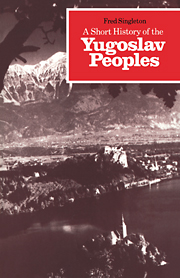Book contents
- Frontmatter
- Contents
- List of tables
- List of maps
- Preface
- Guide to pronunciation
- 1 The lands of the South Slavs
- 2 The early Slav settlers
- 3 The early Slav kingdoms
- 4 The South Slavs under foreign rule
- 5 The development of independence
- 6 The First World War
- 7 The kingdom of Serbs, Croats and Slovenes
- 8 The kingdom of Yugoslavia
- 9 Yugoslavia and the Second World War
- 10 The transition to socialism
- 11 The beginnings of self-management
- 12 The 1960s – a decade of reform
- 13 Tito's last ten years
- 14 Yugoslavia after Tito
- Bibliography
- Index
7 - The kingdom of Serbs, Croats and Slovenes
Published online by Cambridge University Press: 20 February 2010
- Frontmatter
- Contents
- List of tables
- List of maps
- Preface
- Guide to pronunciation
- 1 The lands of the South Slavs
- 2 The early Slav settlers
- 3 The early Slav kingdoms
- 4 The South Slavs under foreign rule
- 5 The development of independence
- 6 The First World War
- 7 The kingdom of Serbs, Croats and Slovenes
- 8 The kingdom of Yugoslavia
- 9 Yugoslavia and the Second World War
- 10 The transition to socialism
- 11 The beginnings of self-management
- 12 The 1960s – a decade of reform
- 13 Tito's last ten years
- 14 Yugoslavia after Tito
- Bibliography
- Index
Summary
The proclamation of 1 December 1918 marked the beginning of a process of nation building which is not yet complete. The tensions which existed between the Yugoslav Committee, representing the Croats, Slovenes and Serbs who had been citizens of the Dual Monarchy, and the Serbs and Montenegrins who lived within their respective kingdoms could not be removed by resolutions passed by politicians who were temporarily carried away by romantic notions of South Slav unity. At no stage in the manoeuvres which accompanied the preparations for the formation of the new state were the aspirations of the Macedonian people taken into account. If they were considered at all, it was as a subordinate branch of the Serbian nation. Even less thought was given to the large number of inhabitants who had no claims to call themselves South Slavs. These included over half a million German-speakers, just under half a million each of Magyars and Albanians, a quarter of a million Romanians and 150,000 Turks. In addition there were Czechs, Slovaks, Ruthenians, Russians, Poles, Italians, Vlahs, Bulgars and Greeks. There were three main religious groups: the Serbian Orthodox and Roman Catholic Christians and the Muslims. There were also tens of thousands of Jews as well as Protestant and Uniate (Greek Catholic) Christians.
In addition to the complexities of the linguistic and religious pattern which the citizens of the new state displayed, there were also formidable administrative problems facing any government attempting to create some form of cohesion from the organisational chaos which it inherited from the collapse of the old order.
- Type
- Chapter
- Information
- A Short History of the Yugoslav Peoples , pp. 131 - 157Publisher: Cambridge University PressPrint publication year: 1985



